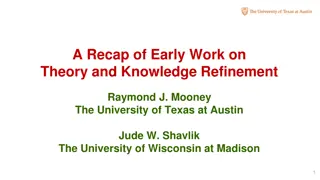Strategies for Rietveld Refinement Using X-ray Diffraction Data
Collection strategies for Rietveld refinement with laboratory X-ray diffraction data involve optimizing conditions for accurate peak intensities. Challenges such as poor particle statistics due to grain size, irradiated volume, or X-ray beam focus must be addressed. Powder diffraction plays a crucial role in crystal structure refinement. The reciprocal space for billions of crystals forms concentric spherical shells intersecting the Ewald Sphere to produce Debye-Sherrer cones.
Download Presentation

Please find below an Image/Link to download the presentation.
The content on the website is provided AS IS for your information and personal use only. It may not be sold, licensed, or shared on other websites without obtaining consent from the author.If you encounter any issues during the download, it is possible that the publisher has removed the file from their server.
You are allowed to download the files provided on this website for personal or commercial use, subject to the condition that they are used lawfully. All files are the property of their respective owners.
The content on the website is provided AS IS for your information and personal use only. It may not be sold, licensed, or shared on other websites without obtaining consent from the author.
E N D
Presentation Transcript
Sofia, September 30, 2015 Data Collection Strategies for Rietveld Refinement Using Laboratory X-ray Diffraction Data J. Rodr guez-Carvajal Diffraction Group Institut Laue-Langevin 1 27/11/2024
The ideal powder diffraction pattern In order to refine a crystal structure with X-ray powder diffraction data the data collection should optimize the conditions for getting the intensities as close as possible to those calculated for the correct structure: 1: Billions of homogeneous and densely packed randomly oriented grains (grains below 10 m) 2: Infinitely thick sample with a smooth and a flat surface for Bragg-Brentano geometry 3: Effective R < 1.5 for Debye-Scherrer geometry 2 27/11/2024
Problems: particle statistics If there are not enough crystallites contributing to the diffraction pattern, then the observed peak intensities will not be as expected Poor particle statistics may be due to: 1: a too large average grain size 2: a too small irradiated volume (very small X-ray beam or not enough amount of material in the sample) 3: a too tightly collimated X-ray beam (e.g. synchrotron radiation needs rotating samples in order to increase the particle statistics) 3 27/11/2024
Powder Diffraction Real space Reciprocal space Single Crystal
Powder Diffraction Real space Reciprocal space Four Single Crystals
Powder Diffraction Reciprocal space Forty Single Crystals
Powder Diffraction Reciprocal space Two hundred Single Crystals
Powder Diffraction In three dimensions the reciprocal space corresponding to billions of crystals is a set of concentric spherical shells. The intersection of these shells with the Ewald Sphere gives rise to powder diffraction as a set of Debye- Sherrer cones
Problems: particle statistics The number of crystallites contributing to a single reflection is a small fraction of the total number of crystallites in the sample. To get a similar number of crystallites for all reflections one has to diminish the size of the grains, increase the divergence of the beam and the acceptance of the detector (receiving slits) (beware! This degrades the resolution) A strong absorbing sample produces a small penetration depth and a weak number of contributing crystallites. 9 27/11/2024
Problems: preferred orientation It is very difficult to avoid preferred orientation when we have plate or needle like shapes of crystallites Top-loading and pressing the powder into a holder, can cause problems with preferred orientation Metallic ingots, sheets or wires lead almost always to preferred orientation due to the manufacturing process. Preferred orientation causes a systematic error in peak intensities that may hamper the refinement of a crystal structure. Full texture of a sample can be determined using X-ray diffraction in a special equipment allowing the orientation of the sample 10 27/11/2024
Powder Diffraction: preferred orientation Preferred orientation is the main limitation factor for exploiting the intensities of X-ray powder diffraction. In order to use powders for structure determination and refinement one has to avoid preferred orientation
Preparing a powder sample Avoid preferred orientation! Diminish the grain sizes and avoid top-loading with pressuring the powder Rotate the sample during the data collection In Bragg-Brentano geometry this allows a better treatment using the March-Dollase model In Debye-Sherrer geometry the possible preferred orientation and particle statistics is strongly diminished 12 27/11/2024
Preparing a powder sample Avoid large crystallite sizes! Large crystallite sizes and non-random crystallite orientations (preferred orientation) lead to peak intensity variations: the measured diffraction pattern will never agree with that expected from an ideal powder 13 27/11/2024
Spotty Debye-Scherrer rings Mixture of fine and coarse grains in a sample 14 27/11/2024
Spotty Debye-Scherrer rings Polycrystalline sample on a single crystal substrate 15 27/11/2024
Preparing a powder sample If you have spotty data from a sample with large grain sizes it is impossible to refine the crystal structure or to do quantitative phase analysis. However: You can determine unit cell lattice parameters and and microstrain In some cases you can determine crystallite size 16 27/11/2024
The knowledge of your diffractometer is crucial for the success of Rietveld refinement The model to calculate a powder diffraction pattern is: h h = + ( ) y I T T b h ci i i = = ( ) x ( ) g x ( ) f x instrumental intrinsicprofile 17 27/11/2024
The knowledge of your diffractometer is crucial for the success of Rietveld refinement The contribution from the instrument can be calculated using the fundamental parameters approach by multiple convolution of the different aberrations due to the optics of the diffractometer and contributions from the sample (this need a nearly perfectly aligned instrument) ( ) ( ) ( ) x g x f x instrumental = = intrinsicprofile We will use a simplified method assuming nearly Voigtian profiles convoluted with axial divergence effects for the instrument contribution 18 27/11/2024
The Voigt approximation for both the sample and the instrument contribution 19 27/11/2024
Profile Parameters (Voigt Approx.) Simple cases: isotropic broadening Parameters controlling the Full-Width at half maximum U, V, W, IG, X, Y I fG = + + + + 2 hG 2 ( )tan tan H U U V W + g f g g 2 cos Y Y g f = + + ( )tan H X X hL g f cos
Instrumental and sample contribution to the broadening I The Gaussian and Lorentzian contributions of the instrument must be determined experimentally with a size/strain- free sample fG = + + 2 hG 2 2 gG tan H U H f 2 cos Y f = + + tan H X H hL f gL cos Sample Instrument
The knowledge of your diffractometer is crucial for the success of Rietveld refinement If you have a Bragg-Brentano diffractometer take the diffraction pattern of a standard sample not having size or strain broadening (e.g. LaB6 from NIST). The diffraction pattern should be taken in exactly the same conditions as your problem sample. You can prepare your own standard if you are able to prepare a sample with similar absorption coefficient as your problem sample and very good crystallinity. For capillary samples Na2Ca3Al2F14 (NAC or Nacalf, from Le Mans, France) is appropriate. 22 27/11/2024
Procedure for working with micro-structural effects in FullProf Characterise the IRF of the diffractometer using calibrating samples Use WinPLOTR for creating an INSTRUMENTAL RESOLUTION FILE (Fit individual peaks through the pattern) or just a refine with FullProf your standard sample Use FullProf with IRF putting to ZERO all FWHM parameters Select a model for microstructure and refine only the parameters related to the sample. The program generates a microstructural file and other files for plot
The format of the file containing the Instrumental Resolution Function The instrumental resolution function file may content keywords that change some variables in the input PCR file if they are used. Now it is possible to read an IRF file for other profiles than NPROF=7. The most simple format for the case RES /= 4,8 is the following: Line 1: General title Next lines containing ! are comments Lines containing one of the keywords: JOBT, WAVE, PROF, ASYM (order does not matter) One or two lines containing the variables (see manual): UINS, VINS, WINS, XINS, YINS, ZINS In case of two lines the second corresponds to instrumental parameters for the second wavelength.
The format of the file containing the Instrumental Resolution Function The keywords in the IRF are accompanied by values as follows: 1: JOBT job (character variable) with job = 'neuc' or 'NEUC' for jobtyp = 3 job = 'neut' or 'NEUT' for jobtyp = 1 job = 'tof' or 'TOF' for jobtyp =-1 job = 'tofc' or 'TOFC' for jobtyp =-3 job = 'xr' or 'XR' for jobtyp = 0 job = 'xrc' or 'XRC' for jobtyp = 2 2: WAVE lambda1, lambda2, ratio (three real values) 3: PROF nprofile, shape1, shape2, shape3 (1 integer and 3 real numbers) 4: ASYM S_L, S_D (two real numbers)
The knowledge of your diffractometer is crucial for the success of Rietveld refinement If you have a Bragg-Brentano diffractometer take the diffraction pattern of a standard sample not having size or strain broadening (e.g. LaB6 from NIST). The diffraction pattern should be taken in exactly the same conditions as your problem sample. You can prepare your own standard if you are able to prepare a sample with similar absorption coefficient as your problem sample and very good crystallinity. For capillary samples Na2Ca3Al2F14 (NAC or Nacalf, from Le Mans, France) is appropriate. 26 27/11/2024























